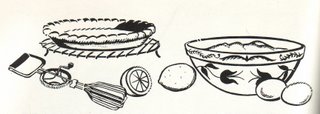 Today, September 26th …
Today, September 26th …Sugar rationing ended in Britain at midnight on Saturday 26th 1953, after 13 years, 8 months, 2 weeks and 6 days (only slightly less than the 13 years, 10 months, 19 days, 17 hours, 32½ minutes of the “noble experiment” of Prohibition in the USA). Ironically - because the philosophy behind the rationing system was to ensure the equitable distribution of supplies to all groups of society - many Britons were better nourished during the war than they had been before, and sugar restriction certainly did no one’s health any harm.
At the onset of rationing in January 1940, the sugar allowance was 12 ounces per person, per week. The exact amount fluctuated over the years, and there were usually extra ounces at Christmas and at jam-making time, but Britons learned to do with less of it, and to substitute with honey or golden syrup when these were available. Creative substitutes were found for many ingredients, but even when the real article was available again (cream, for example), young people who had never acquired a taste for it, retained a preference for the alternative (evaporated milk, for example).
One substitute that never acquired permanent fans was dried egg powder – in spite of copious promotional material from the Ministry of Food, it was stoically accepted or openly despised, but never liked. In April 1953, real eggs came off ration, so with sugar freely available again in late September, home bakers dusted off their old cookbooks with real joy.
One of the advisers for the Ministry of Good during the war was the well-known Marguerite Patten. She related her “feeling of pleasure” when she was able to demonstrate “a real Lemon Meringue Pie” on BBC Television.
Recipe for the Day …
Here is Marguerite Patten’s recipe.
Lemon Meringue Pie.
For the shortcrust pastry:
6 oz (175 g) plain flour.
pinch salt
3 oz. (85g) fat.
water, to bind
Pre-heat the oven to 200oC (400oF).
Sift the flour and salt into a bowl, rub in the fat and add sufficient water to make a dough with a firm rolling consistency. Roll out and use to line a 7-8 inch (18-20 cm) flan tin or ring on an upturned baking tray. Bake blind or 15 minutes or until the pastry is firm but still pale in colour. Remove the pastry shell from the oven and reduce the oven temperature to 150oC (300oF).
While the pastry is cooking, prepare the filling.
For the Filling:
2 small or 1 large lemon(s)
1 oz. (25 g) cornflour or custard powder, whichever is available.
Approx. ½ pint (300 ml) water.
2 oz. (50 g) caster sugar.
2 egg yolks.
½ - 1 oz. (15-3 g) butter or margarine.
Grate the lemon(s) finely to give 1-1 ½ teaspoons lemon zest. Use just the coloured part of the rind so there is no bitter pith. Halve the lemon(s) and squeeze out the juice. You need 3 tablespoons, or 4 tablespoons if you like a very sharp flavour.
Blend the cornflour or custard powder with the cold water. Use the full quantity with 3 tablespoons lemon juice but remove 1 tablespoon water if using the larger amount of fruit juice. Pour into a saucepan, add the lemon zest and juice. Stir over a low heat until the mixture has thickened well. Remove from the heat. Whisk the egg yolks and stir into the lemon mixture with the butter or margarine. Spoon into the partially cooked pastry case, return to the oven and bake for 10 minutes.
For the Meringue:
2 egg whites.
2-4 oz. (50-115 g) caster sugar.
Whisk the egg whites until stiff and gradually fold in the amount of sugar required. If serving the pie hot, you can use the lesser amount. Spoon over the lemon filling and bake for 25 minutes.
Tomorrow’s Story …
Game for Gourmets.
Quotation for the Day …
Love and scandal are the best sweeteners of tea. Henry Fielding, "Love in Several Masques"
1 comment:
Sugar rationing reappeared in the seventies, during the fuel strike, and resulted in my cutting back on sugar, and out altogether in tea.
Post a Comment